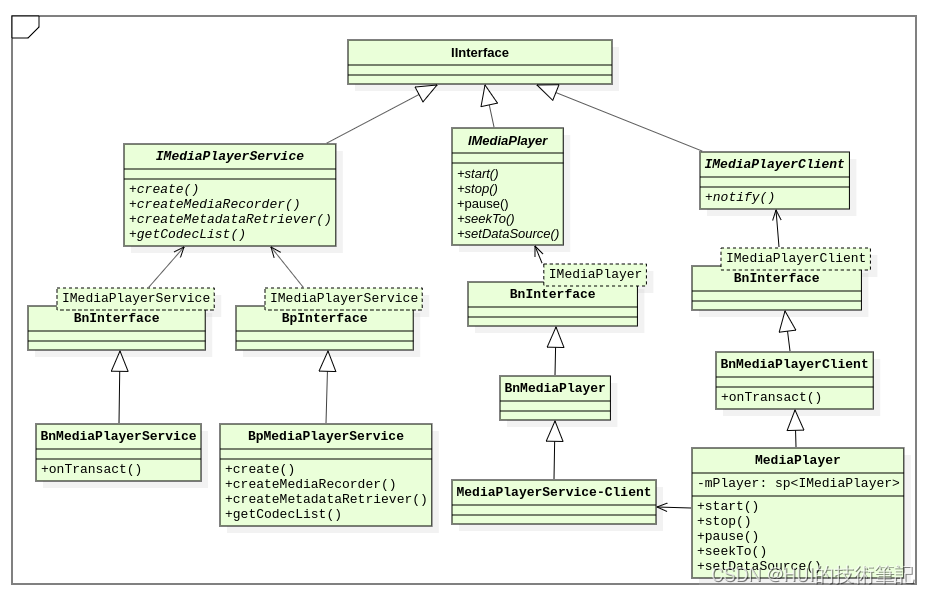MediaPlayer C++实现在libmedia里面,和MediaPlayer.java对应起来,这两者之间通过jni实现android_media_MediaPlayer.cpp联系起来,setDataSource的时候,MediaPlayer会先获取MediaplayerService,然后通过service的create创建MediaPlayerService::Client,MediaPlayer中的
mPlayer就是创建的MediaPlayerService::Client对象。
BP(binder proxy)和BN(binder native)是通过binder来通信的,Bp端可以通过BinderProxy的transact()方法与Bn端发送请求,而Bn端通过继承Binder类并重写onTransact()接收并处理来自Bp端的请求。
Bn意味着Binder Native端,Bp是Binder Proxy端,Bn端通过onTransact()方法接收来自Bp端的请求的代码,然后把结果写入reply,Bp端再从reply中读取返回值并返回给调用者。

MediaPlayer::setDataSource:
status_t MediaPlayer::setDataSource(const sp<IDataSource> &source)
{
ALOGV("setDataSource(IDataSource)");
status_t err = UNKNOWN_ERROR;
const sp<IMediaPlayerService> service(getMediaPlayerService());
if (service != 0) {
sp<IMediaPlayer> player(service->create(this, mAudioSessionId));
if ((NO_ERROR != doSetRetransmitEndpoint(player)) ||
(NO_ERROR != player->setDataSource(source))) {
player.clear();
}
err = attachNewPlayer(player);
}
return err;
}
调用BpMediaPlayerService:: create:
virtual sp<IMediaPlayer> create(
const sp<IMediaPlayerClient>& client, audio_session_t audioSessionId) {
Parcel data, reply;
data.writeInterfaceToken(IMediaPlayerService::getInterfaceDescriptor());
data.writeStrongBinder(IInterface::asBinder(client));
data.writeInt32(audioSessionId);
remote()->transact(CREATE, data, &reply);
return interface_cast<IMediaPlayer>(reply.readStrongBinder());
}
BnMediaPlayerService::onTransact里面创建调用create:
status_t BnMediaPlayerService::onTransact(
uint32_t code, const Parcel& data, Parcel* reply, uint32_t flags)
{
switch (code) {
case CREATE: {
CHECK_INTERFACE(IMediaPlayerService, data, reply);
sp<IMediaPlayerClient> client =
interface_cast<IMediaPlayerClient>(data.readStrongBinder());
audio_session_t audioSessionId = (audio_session_t) data.readInt32();
sp<IMediaPlayer> player = create(client, audioSessionId);
reply->writeStrongBinder(IInterface::asBinder(player));
return NO_ERROR;
} break;
MediaPlayerService::create:
sp<IMediaPlayer> MediaPlayerService::create(const sp<IMediaPlayerClient>& client,
audio_session_t audioSessionId)
{
pid_t pid = IPCThreadState::self()->getCallingPid();
int32_t connId = android_atomic_inc(&mNextConnId);
// MediaPlayerService::Client
sp<Client> c = new Client(
this, pid, connId, client, audioSessionId,
IPCThreadState::self()->getCallingUid());
ALOGV("Create new client(%d) from pid %d, uid %d, ", connId, pid,
IPCThreadState::self()->getCallingUid());
wp<Client> w = c;
{
Mutex::Autolock lock(mLock);
mClients.add(w);
}
return c;
}
然后MediaPlayer持有了MediaPlayerService:: Client对象,player相关的所有操作都是通过这个Client对象完成的。